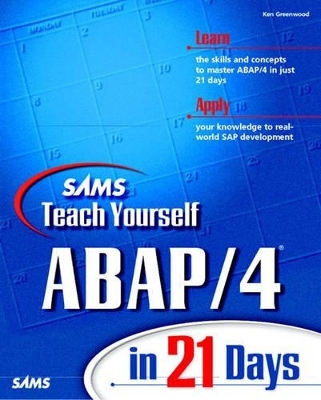
Sams Teach Yourself ABAP/4 in 21 Days
Sams Publishing
978-0-672-31217-5 (ISBN)
- Titel ist leider vergriffen;
keine Neuauflage - Artikel merken
PLEASE PROVIDE
The ideal book for a programmer who must get started in ABAP immediately, and does not want to know the complete story of how and why ABAP was originated. Provides all of the essential information that an ABAP programmer needs and provides it in a readable format. Provides examples that are real and practical not text-book based, like other ABAP programming books. The book also provides insight into the SAP certification process, although not actual coverage of certification because candidates must have two years of practical ABAP programming experience to even enroll in the certification courses!
(NOTE: All chapters, except Chapter 2 and Chapters 17-20 begin with Chapter Objectives and all chapters conclude wtih a Summary, Q&A and Workshop.)WEEK 1. AT A GLANCE.
Day 1. The Development Environment.
What Is R/3? Discovering What R/3 Looks Like. Understanding Basis. Understanding Client/Server. R/3 System Architecture. Application Server Architecture. Using SAP's Open SQL.
Day 2. Your First ABAP/4 Program.
Before Proceeding. Exploring the Development Environment. Discovering Program Types. Discovering Report Components. Creating Your First Program. Exploring the Source Code Editor. Getting Help. Finding Your Development Objects. Introducing the R/3 Data Dictionary. Understanding ABAP/4 Syntax.
Day 3. The Data Dictionary, Part 1.
Discovering R/3 Release Levels. Delving Deeper into the R/3 Data Dictionary. Exploring the Types of Tables in R/3. Exploring Table Components. Naming Conventions for Tables and Their Components. Creating a Transparent Table and Its Components. Modifying Tables. Working with Data.
Day 4. The Data Dictionary, Part 2.
Discovering Foreign Keys. Special Table Fields. Structures in the Data Dictionary.
Day 5. The Data Dictionary, Part 3.
Understanding Table Indexes. Displaying Technical Settings.
Day 6. The Data Dictionary, Part 4.
Automatic Table History and Change Documents. Summarizing the Technical Settings. Revised and Active Versions. Discarding a Revised Version. Using the Database Utility.
Day 7. Defining Data in ABAP/4, Part 1.
Program Buffer and the Roll Area. Elements of ABAP/4 Syntax. Defining Data Objects.
WEEK 1. IN REVIEW.
WEEK 2. AT A GLANCE.
Day 8. Defining Data in ABAP/4, Part 2.
Defining Constants. Defining Field Strings. Defining Types. Structured Types.
Day 9. Assignments, Conversions, and Calculations.
Before Proceeding. Working with System Variables. Finding System Variables. Assignment Statements. Using the clear Statement. Dynamic Assignment.
Day 10. Common Control Statements.
Using the if Statement. Using the case Statement. Using the exit Statement. Using the do Statement. Using the while Statement. Using the continue statement. Using the check statement. Comparing the exit, continue, and check Statements. Simple Position and Length Specifications for the write Statement.
Day 11. Internal Tables.
Internal Table Basics.
Day 12. Advanced Internal Tables, Part 1.
Testing and Modifying Internal Table Contents. Obtaining Information About an Internal Table. Copying Data from One Internal Table to Another. Using the editor-call Statement. Inserting Rows into an Internal Table. Modifying Rows in an Internal Table. Deleting Internal Table Contents. Creating Top 10 Lists Using append sorted by. Filling an Internal Table Using collect.
Day 13. Advanced Internal Table, Part 2.
Filling an Internal Table from a Database Table. Using the lfa1, lfb1, lfc1, and lfc3 Sample Tables. Control Break Processing.
Day 14. The Write Statement.
Default Lengths and Formatting. Additions to the write Statement.
WEEK 2. IN REVIEW.
WEEK 3. AT A GLANCE.
Day 15. Formatting Techniques, Part 1.
Graphical Formatting with the write Statement. Report Formatting and Printing.
Day 16. Formatting Techniques, Part 2.
List Formatting Statements.
Day 17. Modularization: Events And Subroutines.
Modularization Units in ABAP/4. Events. Subroutines.
Day 18. Modularization: Passing Parameters To Subroutines.
Passing Parameters. Defining and Calling External Subroutines.
Day 19. Modularization: Function Modules, Part 1.
Using the include Statement. Introducing Function Modules. Understanding Function Groups. Calling Function Modules. Creating a Function Module.
Day 20. Modularization: Function Modules, Part 2.
Defining Global Data for Function Modules. Passing an Internal Table to a Function Module. Defining Subroutines in a Function Group. Releasing a Function Module. Testing a Function Module. Finding Existing Function Modules. Exploring the Components of Your Function Group. Finding and Fixing Errors in Function Modules. Setting the Value of sy-subrc On Return. Automatically Inserting the call function Statement.
Day 21. Selection Screens.
Event-Driven Programming. Data Validation Using Foreign Keys. Data Validation Using Matchcodes. Formatting Selection Screens. Using selection-screen Statements. Selection Screen Parameters. Selection Screen checkbox. Selection Screen select-options. Selection Screen Radio Buttons. Selection Screen Example Program. Using the Message Statement.
WEEK 3. IN REVIEW
Appendix A. Naming Conventions.
Program Naming Conventions. Customer Name Ranges.
Appendix B. Answers to Quiz Questions and Exercises.
Index.
| Erscheint lt. Verlag | 14.10.1998 |
|---|---|
| Verlagsort | Indianapolis |
| Sprache | englisch |
| Gewicht | 1260 g |
| Themenwelt | Mathematik / Informatik ► Informatik ► Datenbanken |
| Mathematik / Informatik ► Informatik ► Programmiersprachen / -werkzeuge | |
| Informatik ► Weitere Themen ► SAP | |
| Wirtschaft ► Betriebswirtschaft / Management | |
| ISBN-10 | 0-672-31217-4 / 0672312174 |
| ISBN-13 | 978-0-672-31217-5 / 9780672312175 |
| Zustand | Neuware |
| Informationen gemäß Produktsicherheitsverordnung (GPSR) | |
| Haben Sie eine Frage zum Produkt? |